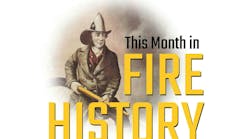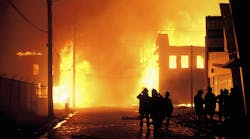Quincy, MA, July 19, 2002 - The annual analysis of deaths of U.S. on-duty firefighters by the nonprofit NFPA (National Fire Protection Association) shows that last year 439 firefighters died, including 340 firefighters from the New York City Fire Department in the World Trade Center attack. (The fire department also lost two paramedics and a chaplain in the incident.)
The report states that more full-time career firefighters perished on Sept. 11 than were killed on-duty over the previous 20 years.
99 on-duty deaths are focus of report
However, while noting the tragic loss of life on that single day, the analysis focuses on the 99 on-duty deaths that occurred elsewhere over the last year. In seven of the last 10 years, fewer than half of firefighters' deaths occurred while they were at fires. A quarter of the deaths happened as firefighters were traveling to or from fires or other emergencies.
The top killer of firefighters in 2001, as it has been in recent years, was overexertion or stress that led to on-the-job heart attacks.
These were the main causes of those 99 firefighters' deaths:
- Heart attacks killed 40. In all cases, the heart attacks were attributed to stress or overexertion. Twelve of those heart attacks occurred at a fire.
- Twenty-seven died from being struck by an object or coming in contact with an object. These include 17 in vehicle crashes.
The chief activities that led to firefighters' deaths were:
- Fighting a fire, 38 deaths
- Traveling to or from a fire, 24 deaths (This includes both crashes and heart attacks.)
- Performing non-emergency duties, such as maintenance, 23 deaths.
Older firefighters were more likely to die than younger ones. Firefighters in their 30s had the lowest death rates, while those in their 50s died at twice the average rate, and those in their 60s at four times the average.
"We all know firefighting is a dangerous profession," says Rita Fahy, Ph.D., manager of fire databases and systems at NFPA. "But some of the biggest dangers occur away from fires. That's why prevention efforts must involve not just training and equipment, but helping firefighters stay in shape and cope with stress. The men and women who protect us deserve no less."
The full report is available in the current issue of NFPA Journal, or in downloadable format from NFPA's Web site, www.nfpa.org.





